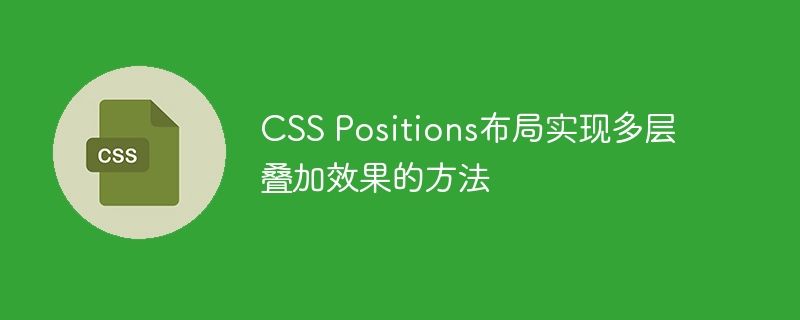Home >Web Front-end >CSS Tutorial >CSS Positions layout method to achieve multi-layer overlay effect
CSS Positions layout method to achieve multi-layer overlay effect
- 王林Original
- 2023-09-26 11:06:291729browse

CSS Positions layout method to achieve multi-layer overlay effect requires specific code examples
In web design, we often need to achieve multi-layer overlay effect and combine different Elements are displayed in different hierarchies. CSS provides a variety of positioning properties that can help us achieve this effect. In this article, we will explore how to use CSS Positions layout to achieve a multi-layer overlay effect, and provide corresponding code examples.
1. Absolute positioning
Absolute positioning is one of the most commonly used positioning methods in CSS. Using absolute positioning, you can position an element relative to its nearest non-statically positioned ancestor element.
Code example:
HTML:
<div class="container"> <div class="layer1"></div> <div class="layer2"></div> <div class="layer3"></div> </div>
CSS:
.container {
position: relative;
width: 400px;
height: 400px;
}
.layer1, .layer2, .layer3 {
position: absolute;
width: 100px;
height: 100px;
}
.layer1 {
background: red;
top: 0;
left: 0;
}
.layer2 {
background: green;
top: 50px;
left: 50px;
}
.layer3 {
background: blue;
top: 100px;
left: 100px;
}In the above code, we create a container element and set it to relative positioning ( position: relative), and then created three layer elements in the container, each set to absolute positioning (position: absolute). By adjusting the top and left properties of layer elements, they appear vertically and horizontally centered in the container. The background colors of different layer elements are different to achieve an overlay effect.
2. Fixed positioning
Fixed positioning is a special absolute positioning method. By setting the position of the element to fixed, the element can be positioned relative to the browser window, even if the page scrolls. The element will also always remain at the specified position.
Code example:
HTML:
<div class="container"> <div class="layer1"></div> <div class="layer2"></div> <div class="layer3"></div> </div>
CSS:
.container {
width: 100%;
height: 1000px;
}
.layer1, .layer2, .layer3 {
position: fixed;
width: 100px;
height: 100px;
}
.layer1 {
background: red;
top: 0;
left: 0;
}
.layer2 {
background: green;
top: 50px;
left: 50px;
}
.layer3 {
background: blue;
top: 100px;
left: 100px;
}In the above code, we create a container element and set its width to 100% , height is 1000px. Then three layer elements were created in the container, also set to fixed positioning (position: fixed). Position the layer element relative to the upper left corner of the browser window by setting its top and left properties.
3. Relative positioning
Relative positioning is to position an element relative to its normal position. Relatively positioned elements are positioned according to the normal document flow.
Code example:
HTML:
<div class="container"> <div class="layer1"></div> <div class="layer2"></div> <div class="layer3"></div> </div>
CSS:
.container {
width: 400px;
height: 400px;
}
.layer1, .layer2, .layer3 {
position: relative;
width: 100px;
height: 100px;
}
.layer1 {
background: red;
top: 0;
left: 0;
z-index: 3;
}
.layer2 {
background: green;
top: 50px;
left: 50px;
z-index: 2;
}
.layer3 {
background: blue;
top: 100px;
left: 100px;
z-index: 1;
}In the above code, we create a container element and create For the three layer elements, set their position property to relative. Adjust the position of layer elements by setting the top and left attributes, and the z-index attribute is used to determine the hierarchical relationship of the layer.
Summary:
By using CSS Positions layout, we can achieve multi-layer overlay effects. Absolute positioning, fixed positioning and relative positioning can all be used to achieve overlay effects. The specific positioning method used depends on the specific needs. When writing code, we need to flexibly use these positioning properties and combine them with other CSS properties to achieve the desired overlay effect.
The above is the detailed content of CSS Positions layout method to achieve multi-layer overlay effect. For more information, please follow other related articles on the PHP Chinese website!

